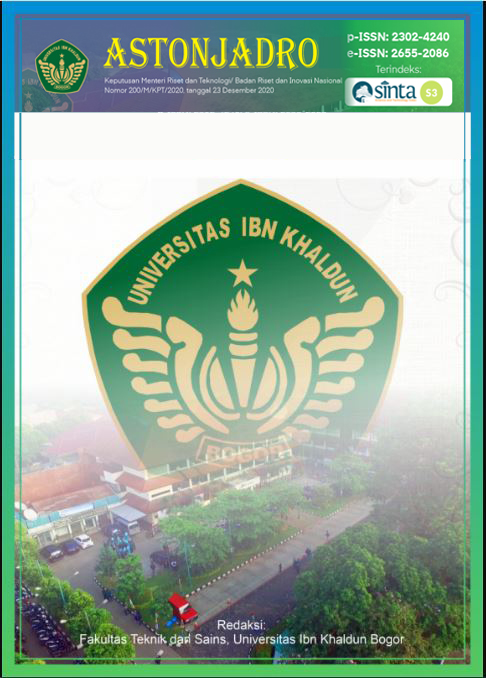Handling and Control of Floods in the Pulukan River/Tukad Macro Drainage System in Jembrana Regency
DOI:
https://doi.org/10.32832/astonjadro.v12i3.14115Keywords:
handling; flood; control; macro; drainage.Abstract
Handling and controlling floods in the river/Tukad macro drainage system as the main discharge is a very complex matter. The engineering dimension (engineering) involves many disciplines. In this study, the analytical review is only on hydrological boundaries, hydraulics, watershed erosion, river engineering, morphology, river sedimentation, handling engineering, and flood control systems. The stages of compiling this research were preceded by the collection of secondary and primary data which were then carried out by analysis. The analysis in this planning is carried out qualitatively, quantitatively, and descriptively. The qualitative description focuses on inventorying the drainage system, determining the zoning of the drainage system based on watershed boundaries, class, and identification of area/area per unit drainage system. The quantitative analysis focuses on hydrological and hydraulic calculations as well as a detailed design of each segment of the drainage channel by the service area of each drainage system. Furthermore, the descriptive analysis focuses on determining the priority scale for the handling of the drainage system which is considered vulnerable to flood hazards in the downstream area. Besides that, it also provides technical and non-technical recommendations for flood management. The results of the analysis of the sedimentation rate of the Pulukan River/Tukad 384.726 tons/ha/year are included in the class of severe erosion hazard because most of the community gardening activities are at an elevation of 25% to 40% which has an impact on the high LS slope factor. The existing cross-sectional capacity of the Pulukan River/Tukad is not able to accommodate the flood discharge planned for a return period of 50 years. From the results of this analysis, it is necessary to carry out flood handling/control using structural and non-structural methods. The Tukad Pulukan Watershed flood management and control program includes; reforestation, river normalization work, river management building, Tukad Pulukan watershed management, community-based watershed management, land use regulation, construction of access road inspections, installation of recording of water level and density of recording stations rainfall.
References
Abdaa, D., & Darfia, N. E. (2021). Analisis Debit Banjir Rencana Das Ambacang Berdasarkan Hidrograf Satuan Sintetis Metode Nakayasu Dan Metode Scs. PROSIDING SNAST, 11–18.
Agusta, I. (2003). Teknik pengumpulan dan analisis data kualitatif. Pusat Penelitian Sosial Ekonomi. Litbang Pertanian, Bogor, 27(10).
Arini, D. I. D., Prasetyo, L. B., & Rusdiana, O. (2007). Aplikasi Sistem Informasi Geografis (Sig) dan Penginderaan Jauh untuk Model Hidrologi Answers dalam Memprediksi Erosi dan Sedimentasi Studi Kasus: Dta Cipopokol Sub DAS Cisadane Hulu Kabupaten Bogor. Media Konservasi, 12(2).
Asdak, C. (2007). Hidrologi dan Pengelolaan Daerah Aliran Sungai (Keempat). Gadjah Mada UNIVERSITY PRESS.
Bahri, Z., & Oemiati, N. (2021). Studi Gerusan Tanah Pada Lereng Sungai Lematang Desa Muara Lawai Kabupaten Muara Enim. Bearing: Jurnal Penelitian Dan Kajian Teknik Sipil, 6(4), 259–267.
Banuwa, I. I. S. (2013). Erosi. Prenada Media.
Br, S. H. (1993). ANALISIS HIDROLOGI (Pertama). PT Gramedia Pustaka Utama.
Djufri, H. (2017). Studi Pengaruh Sudut Belokan Sungai Terhadap Volume Gerusan. INTEK: Jurnal Penelitian, 4(1), 60–65.
Gunawan, G. (2018). Model Peramalan Banjir Air Bengkulu Menggunakan Aplikasi Hec-Ras dan Sistem Informasi Geografis. Seminar Nasional Inovasi, Teknologi Dan Aplikasi (SeNITiA) Universitas Bengkulu, Bengkulu, 238–242.
Krisnayanti, D. S., Udiana, I. M., & Muskanan, M. J. (2018). Pendugaan Erosi dan Sedimentasi Menggunakan Metode Usle dan Musle pada DAS Noel-Puames. Jurnal Teknik Sipil, 7(2), 143–154.
Lesmana, D. M. M., Cahyadi, T. A., SB, W. S. B. W., Nursanto, E., & Winarno, E. (2020). Perbandingan hasil prediksi laju erosi dengan metode usle, musle, rusle berdasar literatur review. Jurnal Sumberdaya Bumi Berkelanjutan (SEMITAN), 2(1), 307–312.
Morgan, R. P. C., Morgan, D. D. V, & Finney, H. J. (1984). A predictive model for the assessment of soil erosion risk. Journal of Agricultural Engineering Research, 30, 245–253.
Muhson, A. (2006). Teknik analisis kuantitatif. Universitas Negeri Yogyakarta. Yogyakarta, 183–196.
Pukan, M. A. G., Pattiraja, A. H., & Seran, S. S. L. M. F. (2022). Analisa Model Kapasitas Tampung Sungai Manikin Dengan Menggunakan Aplikasi Hec-Ras. Eternitas: Jurnal Teknik Sipil, 1(2), 32–40.
Rantung, M. M., Binilang, A., Wuisan, E. M., & Halim, F. (2013). Analisis Erosi dan Sedimentasi Lahan di Sub DAS Panasen Kabupaten Minahasa. Jurnal Sipil Statik, 1(5).
Sari, K. E., Harisuseno, D., & Shafira, C. A. (2018). Pengendalian air limpasan permukaan dengan penerapan konsep ekodrainase (Studi kasus Kelurahan Oro-Oro Dowo Kota Malang). Plano Madani: Jurnal Perencanaan Wilayah Dan Kota, 7(1), 24–36.
Sarosa, S. (2021). Analisis Data Penelitian Kualitatif. Pt Kanisius.
Smith, D. D., & Wischmeier, W. H. (1962). Rainfall erosion. Advances in Agronomy, 14, 109–148.
SOEMARTO, C. . (1993). HIDROLOGI TEKNIK (I. P. W. Indarto (ed.); Kedua). PENERBIT ERLANGGA.
SOEWARNO. (1991). HIDROLOGI. NOVA.
Suripin. (2004). Sistem Drainase Perkotaan Yang Berkelanjutan. ANDI OFFSET.
Sutomo, E. (2017). EFEKTIFITAS DRAINASE RAMAH LINGKUNGAN DALAM MEREDUKSI GENANGAN PADA KAWASAN PERUMAHAN (CIAMPEA KABUPATEN BOGOR). Jurnal Ilmiah Desain & Konstruksi, 16(1).
Syahputra, I., & Rahmawati, C. (2018). Aplikasi Program HEC-RAS 5.0. 3 Pada Studi Penanganan Banjir. Elkawnie: Journal of Islamic Science and Technology, 4(2), 127–140.
Wahidmurni, W. (2017. Pemaparan metode penelitian kualitatif.
Downloads
Published
How to Cite
Issue
Section
License
Copyright (c) 2023 ASTONJADRO

This work is licensed under a Creative Commons Attribution-ShareAlike 4.0 International License.
Paper submitted to ASTONJADRO is the sole property of the Astonjadro Journal. Unless the author withdraws the paper because he does not want to be published in this journal. The publication rights are in the journal Astonjadro.ASTONJADRO
LICENSE
This work is licensed under a Creative Commons Attribution-ShareAlike 4.0 International License.
Based on a work at http://ejournal.uika-bogor.ac.id/index.php/ASTONJADRO













